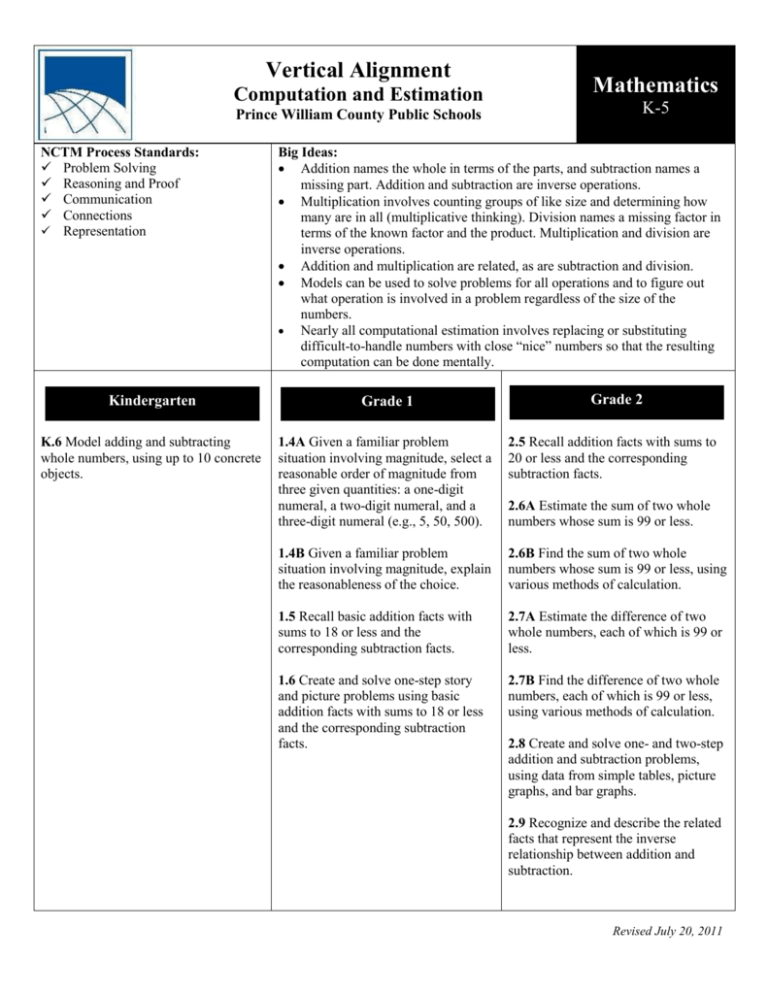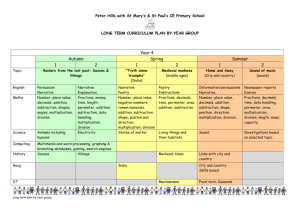Computation and Estimation
advertisement

Vertical Alignment Computation and Estimation Prince William County Public Schools NCTM Process Standards: Problem Solving Reasoning and Proof Communication Connections Representation Mathematics K-5 Big Ideas: Addition names the whole in terms of the parts, and subtraction names a missing part. Addition and subtraction are inverse operations. Multiplication involves counting groups of like size and determining how many are in all (multiplicative thinking). Division names a missing factor in terms of the known factor and the product. Multiplication and division are inverse operations. Addition and multiplication are related, as are subtraction and division. Models can be used to solve problems for all operations and to figure out what operation is involved in a problem regardless of the size of the numbers. Nearly all computational estimation involves replacing or substituting difficult-to-handle numbers with close “nice” numbers so that the resulting computation can be done mentally. Grade 2 Kindergarten Grade 1 K.6 Model adding and subtracting whole numbers, using up to 10 concrete objects. 1.4A Given a familiar problem situation involving magnitude, select a reasonable order of magnitude from three given quantities: a one-digit numeral, a two-digit numeral, and a three-digit numeral (e.g., 5, 50, 500). 2.5 Recall addition facts with sums to 20 or less and the corresponding subtraction facts. 1.4B Given a familiar problem situation involving magnitude, explain the reasonableness of the choice. 2.6B Find the sum of two whole numbers whose sum is 99 or less, using various methods of calculation. 1.5 Recall basic addition facts with sums to 18 or less and the corresponding subtraction facts. 2.7A Estimate the difference of two whole numbers, each of which is 99 or less. 1.6 Create and solve one-step story and picture problems using basic addition facts with sums to 18 or less and the corresponding subtraction facts. 2.7B Find the difference of two whole numbers, each of which is 99 or less, using various methods of calculation. 2.6A Estimate the sum of two whole numbers whose sum is 99 or less. 2.8 Create and solve one- and two-step addition and subtraction problems, using data from simple tables, picture graphs, and bar graphs. 2.9 Recognize and describe the related facts that represent the inverse relationship between addition and subtraction. Revised July 20, 2011 Grade 3 3.4 Estimate solutions to and solve single-step and multistep problems involving the sum or difference of two whole numbers, each 9,999 or less, with or without regrouping. 3.5 Recall multiplication facts through the twelves table, and the corresponding division facts. 3.6 Represent multiplication and division, using area, set, and number line models, and create and solve problems that involve multiplication of two whole numbers, one factor 99 or less and the second factor 5 or less. 3.7 Add and subtract proper fractions having like denominators of 12 or less. Grade 4 4.4A Estimate sums, differences, products, and quotients of whole numbers. 4.4B Add, subtract, and multiply whole numbers. 4.4C Divide whole numbers, finding quotients with and without remainders. 4.4D Solve single-step and multistep addition, subtraction, and multiplication problems with whole numbers. 4.5A Determine common multiples and factors, including least common multiple and greatest common factor. 4.5B Add and subtract fractions having like and unlike denominators that are limited to 2, 3, 4, 5, 6, 8, 10, and 12, and simplify the resulting fractions, using common multiples and factors. Grade 5 5.4 Create and solve single-step and multistep practical problems involving addition, subtraction, multiplication, and division with and without remainders of whole numbers. 5.5A Find the sum, difference, product, and quotient of two numbers expressed as decimals through thousandths (divisors with only one non-zero digit). 5.5B Create and solve single-step and multistep practical problems involving decimals. 5.6 Solve single-step and multistep practical problems involving addition and subtraction with fractions and mixed numbers and express answers in simplest form. 5.7 Evaluate whole number numerical expressions, using the order of operations limited to parentheses, addition, subtraction, multiplication, and division. 4.5C Add and subtract with decimals. 4.5D Solve single-step and multistep practical problems involving addition and subtraction with fractions and with decimals. Revised July 20, 2011 Vertical Alignment: Computation and Estimation Prince William County Public Schools NCTM Process Standards: Problem Solving Reasoning and Proof Communication Connections Representation Grade 6 6.6A Multiply and divide fractions and mixed numbers. 6.6B Estimate solutions and then solve single-step and multi-step practical problems involving addition, subtraction, multiplication, and division of fractions. 6.7 Solve single-step and multi-step practical problems involving addition subtraction, multiplication, and division of decimals. Mathematics 6–8 Big Ideas: Bringing meaning to why procedures work (or sense-making) is critical in developing conceptual and algorithmic understanding of operations with integers and rational numbers. Estimation is one strategy for solving a problem. There are real life situations when exact answers are appropriate and others when estimates are equally appropriate. Making valid judgments regarding the reasonableness of an answer is part of problem-solving. Skills with operations with whole numbers, fractions, and decimals are critical in problem-solving and applications. Grade 7 Grade 8 7.3A Model addition, subtraction, multiplication, and division of integers. 8.3A Solve practical problems involving rational numbers, percents, ratios, and proportions. 7.3B Add, subtract, multiply, and divide integers. 8.3B Determine the percent increase or decrease for a given situation. 7.4 The student will solve single-step and multi-step problems, using proportional reasoning. 8.4 Apply the order of operations to evaluate algebraic expressions for given replacement values of variables. 6.8 Evaluate whole number numerical expressions, using order of operations. Revised July 20, 2011








